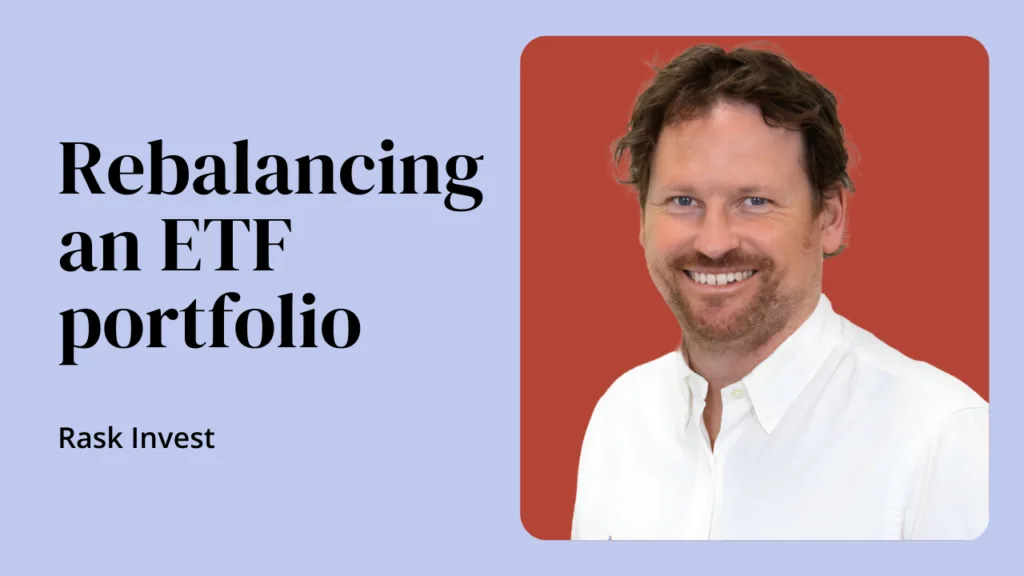Buying ETFs is easy but when do you rebalance your ETF portfolio and how do you do it? This is a question I find a lot of people struggle with.
Rebalancing is one of the most important aspects of managing an investment portfolio. Without it, your asset allocation can drift over time, exposing you to more risk than intended.
At Rask Invest, we take a weighting-based approach to rebalancing—adjusting portfolios only when necessary rather than on a fixed schedule. This method reduces unnecessary tax events and brokerage costs, ensuring long-term efficiency.
This 4-step guide will walk you through:
- Why rebalancing is important
- The difference between time-based and weighting-based rebalancing
- When and how we rebalance portfolios at Rask Invest
- Real-world examples to help you apply these principles
Step 1: Understanding portfolio asset allocation & rebalancing
Every portfolio has a target asset allocation. At Rask Invest, we categorise assets into two groups. Below is an example of our Jupiter High Growth Portfolio:
| Asset Class | Allocation (%) | Category |
|---|---|---|
| International Equities | 50% | Growth |
| Australian Equities | 40% | Growth |
| Fixed Interest & Cash | 10% | Defensive |
Over time, market movements can cause these percentages to shift. Rebalancing ensures the portfolio stays aligned with the target allocation and risk tolerance.
Why rebalancing matters
- Portfolio drift: Most investors will start out with a set allocation. Over time this will shift, you will reinvest dividends and in time a balanced portfolio may start looking like a growth portfolio or even high growth. Leaving you exposed.
- Market Drops: If equities fall in value, defensive assets become a larger part of the portfolio. At Rask Invest, we sell defensive assets and buy more equities at lower prices—a classic “buy low” strategy.
- Market Rallies: If equities grow faster than defensive assets, the portfolio may become overweight in stocks. We sell some equities and reinvest in defensive assets to maintain balance.
- Cash Deposits: Adding funds increases the percentage of cash in the portfolio. If cash exceeds 5% of total value, we invest the excess to align with the model allocation.
- Rebalancing is not market timing: It’s really important to note that rebalancing is not market timing. Rebalancing is rules based and realigns your portfolio with your static allocation, market timing is based on forecasting the future (or just plain guessing).
Step 2: Choosing a portfolio rebalancing approach
There are two main methods of rebalancing:
1. Time-based rebalancing (traditional method)
- Rebalances on a fixed schedule (e.g., quarterly)
- Ignores market conditions
- Can create unnecessary tax events and trading costs
- Allows for minimal drift
2. Weighting-based rebalancing (Rask Invest’s method)
- Rebalances only when allocations drift 10%+ from the target
- Reduces unnecessary trading and costs
- Allows for the natural, long-term movement of each asset class to impact your portfolio
- Provides a mechanism for discipline in a charging or falling market
| Method | When It rebalances | Pros | Cons |
|---|---|---|---|
| Time-based | Every quarter (or another fixed period) | Simple, predictable | Ignores market conditions, may cause unnecessary trades & tax events |
| Weighting-based (Rask Invest) | Only when asset allocations drift 10%+ from target | Minimises costs, buys low & sells high | Requires monitoring |
Step 3: When do we rebalance at Rask Invest?
At Rask Invest, we rebalance when:
- Natural drift from our desired split: Market falls are just as natural as a rising market. We set our rebalance rule at 10% divergence from our growth to defensive split.
- Market drops significantly → Defensive assets increase → We sell defensive assets, buy more equities
- Market rallies → Equities increase → We trim equities, buy defensive assets
- New cash deposits increase cash above 5% of the portfolio → We invest excess cash. This includes dividends too.
Example 1: Market drop rebalancing
Suppose the market declines, causing a portfolio to shift from 90% growth / 10% defensive to 80% growth / 20% defensive.
| Asset Class | Target Allocation | Current Allocation | Action (Rask Invest) |
|---|---|---|---|
| International Equities | 50% | 45% | Buy |
| Australian Equities | 40% | 35% | Buy |
| Fixed Interest & Cash | 10% | 20% | Sell |
Why? Selling now overweight defensive assets and buying equities at lower prices, Rask Invest maintains our desired risk balance and may benefit from market downturns.
Example 2: Cash deposit rebalancing
If an investor deposits $10,000, their portfolio’s cash allocation may increase to 15%.
| Asset Class | Target Allocation | Current Allocation | Action (Rask Invest) |
|---|---|---|---|
| International Equities | 50% | 45% | Buy |
| Australian Equities | 40% | 35% | Buy |
| Cash | 5% | 15% | Invest |
Why? Holding excess cash can reduce long-term returns. We invest the new cash in the portfolios underweight positions to realign the portfolio with the target model.
Step 4: How we rebalance client portfolios at Rask Invest
Step 1: Monitor asset allocation regularly
We track portfolio allocations and check for a 10%+ drift from targets.
Step 2: Identify what to buy or sell
- If growth assets are overweight, we sell and reallocate to defensive assets.
- If defensive assets are overweight, we sell and buy more growth assets.
Step 3: Execute trades efficiently
- We minimise unnecessary trades through our minimum transaction value rules, keeping transaction costs low ($4.40 or 0.044% per trade).
- We consider tax implications before making changes to our asset allocation at the model level.
- We take dividends in cash and use that cash to buy units in the ETFs we need to realign the portfolio with the model.
Step 4: Monitor & Adjust as Needed
We continuously review portfolios and rebalance only when necessary, rather than at arbitrary intervals.
Key takeaways
- Rebalancing keeps your portfolio aligned with your goals & risk tolerance
- Weighting-based rebalancing (Rask Invest’s approach) is more cost-efficient than time-based rebalancing
- Rebalancing is triggered by significant allocation drift, not arbitrary dates
- Market drops present opportunities—Rask Invest buys low, selling defensive assets to reinvest in equities
- Rebalancing is not the same as market timing, don’t get the two confused.
Final thought
At Rask Invest, we take a smart, cost-effective approach to portfolio rebalancing. By rebalancing only when necessary, we reduce costs, minimise tax events, and maintain a balance between risk and returns.
You can view more on Rask Invest here. If you would like to get in contact with me you can use the chat function in the bottom right corner, use the book a call function or say hello on our Community.


